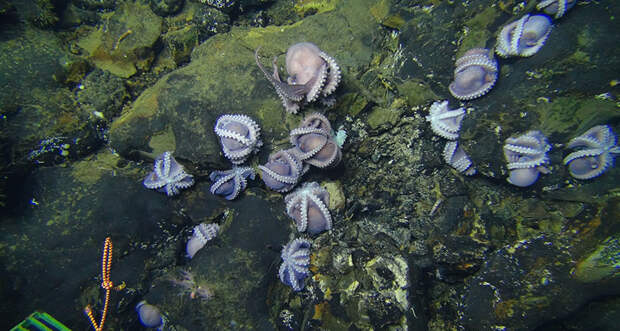Author: Sarah Zielinski / Source: Science News for Students

A geology voyage to study the fluid coming from a rocky outcrop deep below the ocean’s surface turned up something unexpected. It was a population of purple octopuses brooding their young.
The colony is probably doomed due to the warm flow of low-oxygen water coming out of the rock. However, those ill-fated animals may be an indicator that healthy kin are hiding out nearby. That’s the conclusion of a new study.The octopuses reside at a site 3,000 meters (1.8 miles) deep called Dorado Outcrop. It’s some 250 kilometers (155 miles) off the coast of the Central American country of Costa Rica. The outcrop is essentially a buried, 23-million-year-old mountain.
“Fluid is discharging from this outcrop because at some other location there’s fluid flowing from the bottom of the ocean into the earth,” notes Anne Hartwell. She’s a marine research scientist with the University of Alaska Fairbanks. Just where that fluid is entering isn’t known. What path that the water takes through the earth is also a mystery.
But geoscientists were curious about emerging fluid. That’s why they visited the site in 2013. They sent a remote-controlled research vehicle called Jason II to take images. Those images revealed a wealth of brooding octopuses clinging onto the side of the outcrop. “Everyone thought they were cool, but no one really did anything about it,” Hartwell says. “There were biologists on board,” she adds.
“But they were microbiologists.” (Microbiologists study small organisms, such as bacteria.)Hartwell wasn’t on that trip. But she was on another one a year later that visited the site in the research submarine ALVIN. “When I got to the seafloor … there was so much life,” she recalls. The octopuses…
The post Deep-sea expedition led researchers to doomed octopus nursery appeared first on FeedBox.